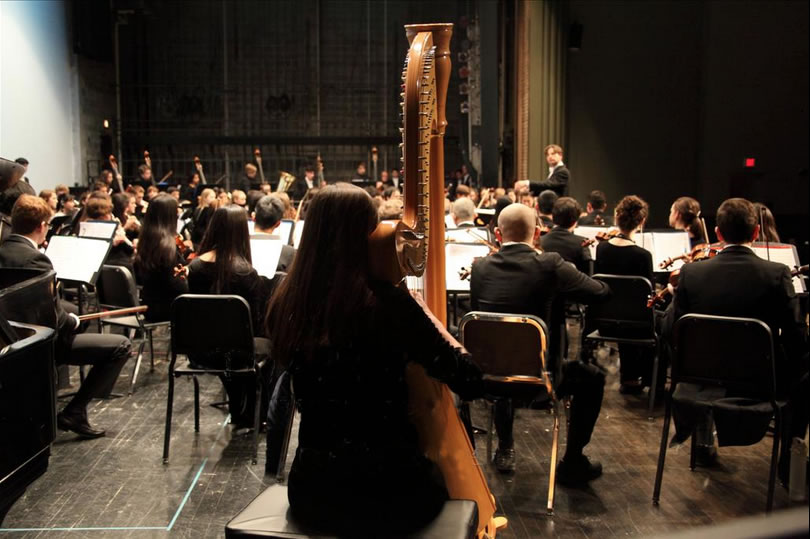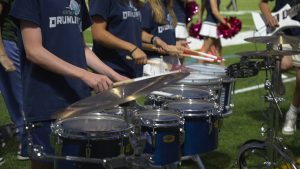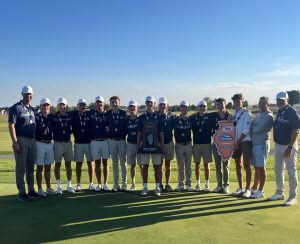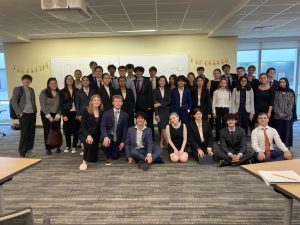Music Day fights for student attendance
Some students uninterested, but performers see the merit
February 26, 2016
On Feb. 11, the New Trier Music Department highlighted their capstone ensembles in a series of short performances during periods 4-6 in their annual Music Day.
Music Day featured performances from Symphonic Wind Ensemble, Symphony Orchestra, Jazz band, Choir Opera, Concert Choir, and Swing Choir. Lower ensembles were unable to take part in the show due to the time constraint. The participating groups were limited to five minutes to perform.
Matthew Temple, conductor of Symphonic Wind Ensemble, directed his band in a five-minute excerpt of “Give Us This Day,” a fifteen-minute piece they’ve been working on for their spring concert in March.
“We usually try to do something that’s a little flashy and fast,” said Temple, “something that’s entertaining for any person, whether they’re a musician or not.”
Other ensembles strived to appeal to non-musicians, too. Nicholas Meyer, director of Jazz Band, saw Music Day as a chance for the music department to showcase their students’ achievement.
“I think most students have an understanding of the fact that New Trier has a strong music program,” Meyer said.
“But I think for a lot of students who aren’t in the music program, they don’t actually get to hear the proof of that.”
Many students have compared Music Day to the older and more established Dance Day because of the similarities between their concepts. However, Music Day seems to have a much lower attendance rate in comparison.
Several musicians say that the low attendance may be caused by lack of awareness. While Temple pointed out that the day was advertised on monitors and posters around the school, it hasn’t yet gained much attention from students and teachers.
According to Nina Chatrath, a junior in Symphony Orchestra, the attendance may be a result of the limited amount of people who know about the event. “Since it’s not an all-day thing, and not so many people are involved, not a lot of people know about it,” Chatrath said.
The most evident reason for the differences in attendance between these shows seems to be the amount of time each show has been running. Starting in 2012, Music Day has been running for only four years so far.
“New Trier is an institution that relies heavily on tradition,” said Meyer. “Dance Day has been a tradition for a long time.”
“When Dance Day was created countless years ago, they actually went through the same period, too, where initially it wasn’t as popular. It took several years for people to really clue into it. Music Day is sort of evolving the same way,” Temple said.
Peter Rosheger, conductor of Symphony Orchestra, confirmed that “attendance has grown over the years.” Temple has already seen this growth and said, “Fourth period, which was the first performance [of the day], was the largest audience we’ve had yet. The main floor of the auditorium was almost full.”
Participating students see the benefits of Music Day as well. Rohan Daruwala, a senior in Symphony Orchestra, Symphonic Wind Ensemble, and Jazz, said, “It gives us an opportunity to perform for people who would never normally come to our concerts.”
Emiel De Jaegher, a senior in the same three ensembles, also thought it was important that non-music students could see the show. “We have such a strong music program, and not as many people know about it as they know about our sports teams,” De Jaegher said.
“It is especially important to note that musicians are just like athletes. We work hard to do the best we can do on our instruments and we do it all year round.”
Meyer pointed out the similarities between music and athletics as well. Although musical ensembles do get the chance to perform in concerts after school, those shows are mostly attended by family and community members.
“There are other activities or disciplines within the school where those students get to present their work in sort of a natural way,” Meyer said. “We feel strongly that our music students should have the opportunity to present their work to their school community.”












































